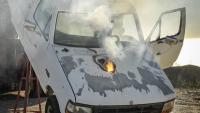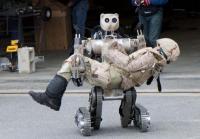-
Microwave absorber may advance radar cloaking for stealth missions

Microwave absorbers are a kind of material that can effectively absorb incident microwave energy to make objects invisible to radar; therefore they are commonly used in aircraft cloaking and warship stealth. Recently, as radar detection devices have been improved to detect the near-meter microwave length regime, scientists are working on high-performance absorbers that can cloak objects in the equivalent ultra-high frequency regime (from 300 megahertz to two gigahertz). Conventional absorbers for the ultra-high regime, however, are usually thick, heavy, or have narrow absorption bandwidth, making them unsuitable for stealth missions. To solve this problem, researchers have developed an ultra-thin, tunable broadband microwave absorber for ultra-high frequency applications.
-
-
Climate change heightening the risk of conflict and war
Thirty of Australia’s leading minds from defense, academia, policy think tanks, and other government agencies have joined together for discussions over two days last week for Australia’s first climate security summit. The summit participants agreed that increasing temperatures, rising sea levels, changing rainfall patterns, and more frequent and severe extreme weather events are heightening the risk of conflict and increasing the displacement of people. The summit organizers quote Brigadier-General Wendell Christopher King (Ret.), the Chief Academic Officer at the U.S. Army’s Command and General Staff College, who said: “[Climate change] is like getting embroiled in a war that lasts 100 years — there is no exit-strategy.”
-
-
ACLU lawsuit seeks disclosure of details of CIA drone program
The American Civil Liberties Union (ACLU) is continuing its campaign over CIA drone use with a lawsuit filed on Monday to force the CIA to turn over details about the U.S. clandestine drone war program. The ACLU lawsuit, coming a week after some of details of the program were leaked, asks for summary data from the CIA on drone strikes, including the locations and dates of strikes, the number of people killed and their identities or status.
-
-
Airborne networking capabilities for hostile environments
Modern airborne warfare is becoming increasingly complex, with manned and unmanned systems having rapidly to share information in a volatile environment where adversaries use advanced, commercially available electronic systems to disrupt U.S. and allied communications. DARPA’s Dynamic Network Adaptation for Mission Optimization (DyNAMO) program. DyNAMO seeks novel technologies which would enable independently designed networks to share information and adapt to sporadic jamming and mission-critical dynamic network bursts in contested RF environments.
-
-
Anti-drone defense system now features quad band RF inhibitor, optical disruptor
The world’s first fully integrated detect-track-disrupt Anti-UAV Defense System (AUDS) — launched by a trio of British companies in May this year — now features a quad band radio frequency (RF) inhibitor/jammer, an optical disruptor, and rapid deployment features in the final production version of the counter-drone system. The companies say that these enhancements follow extensive customer trials of the pre-production system across Europe and North America over the spring and summer.
-
-
Lockheed Martin begins production of modular high-power laser

Lockheed Martin has begun production of a new generation of modular high power lasers this month. The first laser built using the modular technique will be a 60-kilowatt system for a U.S. Army vehicle. The Army has the option to add more modules and increase power from 60kW to 120kW. Laser weapons provide a complement to traditional kinetic weapons in the battlefield. In the future, they will offer reliable protection against threats such as swarms of drones or large numbers of rockets and mortars.
-
-
How Syria is becoming a test bed for high-tech weapons of electronic warfare

Russia’s military presence in Syria has been steadily increasing over the past few months. The latest reports are that Russia has also deployed its most modern electronic warfare system to Syria — the Krasukha-4 (or Belladonna) mobile electronic warfare (EW) unit. The Krasukha-4 is a broad-band multifunctional jamming system designed to neutralize Low-Earth Orbit (LEO) spy satellites such as the U.S. Lacrosse/Onyx series, airborne surveillance radars and radar-guided ordinance at ranges between 150km to 300km. U.S. and NATO intelligence gatherers will have “electronic counter countermeasures” (ECCM) to combat Russian EW interference — and so the cat and mouse game of the cold war is repeated. Intelligence gathering and radar-guided munitions will suffer some disruption and mistakes may be made but operations will continue. Russia will now be able to test its new EW systems in live combat but avoiding direct conflict with NATO — it will enhance overseas sales prospects of the Krasukha-4 system. NATO will be able test its ECCM against another EW system, presumably with similar ends in mind.
-
-
Strengthening U.S. cybersecurity capabilities by bolstering cyber defense, deterrence
Top officials from the Defense Department and the intelligence community told a Senate panel that defense and deterrence are two of the highest priorities for bolstering the nation’s cybersecurity capabilities. Director of National Intelligence James R. Clapper said that for the third year in a row, cyberthreats headed the list of threats reported in the annual National Intelligence Worldwide Threat Assessment. “Although we must be prepared for a large Armageddon-scale strike that would debilitate the entire U.S. infrastructure, that is not … the most likely scenario,” Clapper said. Rather, the primary concern is low- to moderate-level cyberattacks from a growing range of sources that will continue and probably expand, adding that in the future he expects to see more cyber operations that manipulate electronic information to compromise its integrity, as opposed to deleting or disrupting access to it.
-
-
Clothing that guards against chemical warfare agents
Recent reports of chemical weapons attacks in the Middle East underscore the need for new ways to guard against their toxic effects. Scientists report that a new hydrogel coating that neutralizes both mustard gas and nerve agent VX. It could someday be applied to materials such as clothing and paint.
-
-
Protecting Navy ships from cyberattacks
For most people, the term “cyber security” calls to mind stories of data theft like the recent hacks of the OPM database, or network spying like the 2012 breach of the Navy-Marine Corps Intranet. But in this networked world, hackers might also try to disable or take control of machines in our physical world — from large systems like electric power grids and industrial plants, to transportations assets like cars, trains, planes or even ships at sea.
-
-
Robots to pull wounded soldiers off battlefield

Most Americans have seen at least one war movie, where at some point a fresh-faced young private is hit with some shrapnel. From the ground, he calls out for the unit medic — another young guy, from another small town, whose quick reaction and skill just may save his life. In the near future, however, it may no longer be another soldier, who comes running to his side. Instead, it might be an Army-operated unmanned aerial or ground vehicle.
-
-
Beyond data theft: Next phase of cyber intrusions will include destruction, manipulation of data
James Clapper, director of U.S. intelligence, and other senior intelligence officers, have warned Congress that the next phase of escalating online data theft will likely involve the manipulation of digital information. Clapper on Wednesday told lawmakers on the House Intelligence Committee that a “cyber Armageddon,” in which a digitally triggered damage to physical infrastructure results in a series of catastrophic events, is less likely than “cyber operations that will change or manipulate data.” Leaders of the U.S. intelligence community told lawmakers that the manipulation or destruction of data would undermine confidence in data stored on or accessible through U.S. networks, engendering an uncertainty which could jeopardize U.S. military situational awareness and undermine business activity.
-
-
UN inquiry to determine who is responsible for chemical attacks in Syria
Russia has withdrawn its objections to a UN investigation into identifying the culprits responsible for chemical attacks in Syria, allowing a probe to begin, UN diplomats said Thursday. For the last two years, Russia had insisted that a series of UN investigative teams sent to Syria would be limited to finding out whether or not chemical weapons had been used, but would be barred from identifying who was responsible for launching them.
-
-
Russian-American admits to smuggling sensitive weapon tech to Russia
Alexander Fishenko, 49, a Russian-American businessman, pleaded guilty yesterday (Wednesday) to charges of smuggling sensitive U.S. microelectronics to Russia. He was arrested in 2012 on allegations that he had shipped export-controlled electronics and computer chips which are used in radar and surveillance systems, missile guidance systems, and detonation triggers.
-
-
Engineers design invisibility cloak for military drones
Inspired by the well-known Invisibility Cloak from Harry Potter, electrical engineers have created a new design for their cloaking device, using a Teflon substrate, studded with cylinders of ceramic, which is thinner than any prior development and does not alter the brightness of light around concealed objects. The Teflon has a low refractive index, while the ceramic’s refractive index is higher, which allows light to be dispersed through the sheet without any absorption. Compared to an invisibility cloak, this technology has not only the ability to conceal, but the ability to increase optical communication signal speed and to collect solar energy.
-
More headlines
The long view
Tantalizing Method to Study Cyberdeterrence
Tantalus is unlike most war games because it is experimental instead of experiential — the immersive game differs by overlapping scientific rigor and quantitative assessment methods with the experimental sciences, and experimental war gaming provides insightful data for real-world cyberattacks.
Testing Cutting-Edge Counter-Drone Technology
Drones have many positive applications, bad actors can use them for nefarious purposes. Two recent field demonstrations brought government, academia, and industry together to evaluate innovative counter-unmanned aircraft systems.
European Arms Imports Nearly Double, U.S. and French Exports Rise, and Russian Exports Fall Sharply
States in Europe almost doubled their imports of major arms (+94 per cent) between 2014–18 and 2019–23. The United States increased its arms exports by 17 per cent between 2014–18 and 2019–23, while Russia’s arms exports halved. Russia was for the first time the third largest arms exporter, falling just behind France.
How Climate Change Will Affect Conflict and U.S. Military Operations
“People talk about climate change as a threat multiplier,” said Karen Sudkamp, an associate director of the Infrastructure, Immigration, and Security Operations Program within the RAND Homeland Security Research Division. “But at what point do we need to start talking about the threat multiplier actually becoming a significant threat all its own?”
The Tech Apocalypse Panic is Driven by AI Boosters, Military Tacticians, and Movies
From popular films like a War Games or The Terminator to a U.S. State Department-commissioned report on the security risk of weaponized AI, there has been a tremendous amount of hand wringing and nervousness about how so-called artificial intelligence might end up destroying the world. There is one easy way to avoid a lot of this and prevent a self-inflicted doomsday: don’t give computers the capability to launch devastating weapons.
